The Life of G Campbell Morgan
G. Campbell Morgan: 9 December 1863 – 16 May 1945 [81 yrs old]
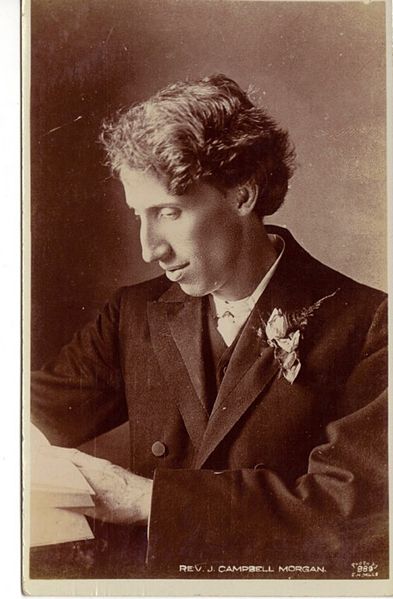
Morgan in 1907
The Early Years: 1863-1883
G. Campbell Morgan (the “G” stands for George), was born December 9, 1863, on a farm in Tetbury, England. A highly regarded preacher and Bible teacher in England, known as the “Prince of Expositors,” Morgan worked closely with D. L. Moody, F. B. Meyer and Martyn Lloyd-Jones and for over 20 years was pastor of Westminster Chapel. The life of G Campbell Morgan was a powerful and far-reaching one: he preached over 23,000 sermons on both sides of the Atlantic and left an amazing legacy in written books and sermons that still encourage, instruct and challenge today!
G. Campbell was the son of George Morgan (a Welshman) who was a member of the strict Plymouth Brethren but later resigned and became a Baptist minister. George (the younger, who usually went by Campbell) was very sickly as a child, could not attend school, and so was tutored at home.
When Campbell was 10 years old, D. L. Moody came to England for the first time. Though he did not meet him on that occasion, Moody’s ministry stirred the country and, combined with the dedication of his parents, made a great impression on the young Morgan. At the age of 13 he preached his first sermon at Monmouth Methodist Church on Sunday, August 27, 1876, and then afterwards regularly preached as a “boy preacher” in country chapels on Sundays and holidays.
He had a time of crisis and despair, which he called an “eclipse” of his faith, from age nineteen to twenty-one. His faith had been shaken by the popular philosophies of the day and he could no longer say he believed the Word of God to be fully true. Of this time he later said,
For two years my Bible was shut; two years of sadness and sorrow. Strange, alluring materialistic theories were in the air, and to these I turned … I became well-versed in the philosophies that were the vogue in England at that time, but from them I got no relief. In my despair I took all the books that I had, placed them in a cupboard, turned the key, and there they remained for seven years. I bought a new Bible, and began to read it with an open mind and a determined will. That Bible found me. The Book gave forth a glow which warmed my heart, and the Word of God which I read to therein gave to my troubled soul the relief and satisfaction that I had sought for elsewhere. Since that time I have lived for one end—to preach the teachings of the Book that found me.
Beginning in Ministry: 1883-1904
Around that time Morgan was accepted as a school teacher at the Jewish Collegiate School for Boys, [1] an experience that would be formative for his future ministry of expository work. Working with the head Rabbi for three years, even helping students with their bar-mitzvah preparations, enabled Morgan to gain fresh insights into Jewish life and the Hebrew Scriptures.
Also in 1883, Moody returned to England for a second trip and this time Morgan had the privilege of volunteering and working in the powerful meetings. A couple of years later, in 1885, he had the opportunity to go to London for the first time where he, among other things, heard C. H. Spurgeon preach. Sometime later that same year he became friends with Albert Swift – a friendship which would have a great impact on his ministry and later pastorate at Westminster Chapel.
In 1886, at the age of 23, he left the teaching profession and devoted himself to preaching and Bible exposition. He was first associated with the Salvation Army and threw himself into the work. He began keeping a diary in 1886 and one entry in July of that year reads:
Prayer meeting this morning at 7.
Open-air at 10.
Inside meeting at 11.
In the afternoon, open-air at 2.
Inside at 3.
Open-air at 5:30.
Inside at 6:30
Good meetings all day. The power of God was very present with us.”
That year the famous evangelist Gipsy Smith preached a series of meetings in Hull, attended by thousands, with many coming to faith. Some of the leaders in the Salvation Army there invited Morgan to follow up the meetings with a two-week mission aimed at follow-up work. Those two weeks turned into a ministry of over one year, and solidified in Morgan’s young heart the great need for both evangelism and discipleship. It also began a friendship with Gipsy Smith that lasted for over sixty years.
Apparently, around this time he approached Catherine Booth to discuss future full-time work with the Salvation Army. An account in the 1902 edition of the “Moody Monthly” magazine noted the conversation:
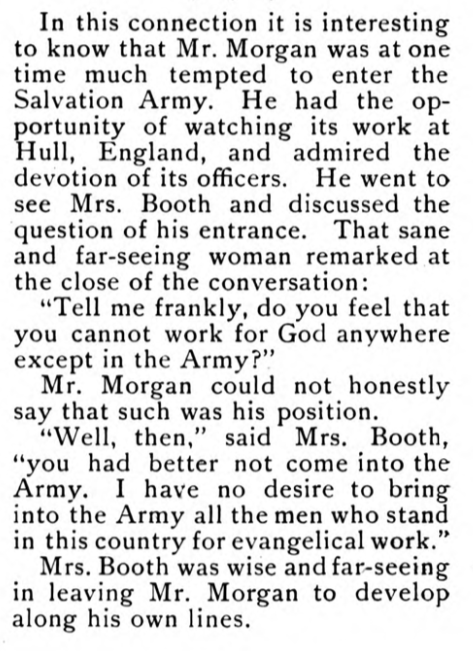
Having decided not to pursue further ministry with the Salvation Army, in 1888 he attempted to become a Wesleyan Methodist minister, but was rejected by the Methodist examiners when he preached his trial sermon for them. (He wasn’t the only one – apparently 105 of the 150 applicants that year were rejected!) Morgan wired to his father a one word summary: “Rejected.” His father quickly sent a message back:
Rejected on earth. Accepted in heaven. Dad.”
Another momentous event took place later that year – in August 1888 Morgan wed Nancy – a petite, good-natured young lady who would prove to be a wonderful companion and source of strength and encouragement in the years that would follow.

First Church Pastorates
For the months after their marriage, Morgan was involved mostly in itinerant evangelistic work, with Nancy helping alongside him and often singing in the meetings with her beautiful soprano voice. Exactly a year following their marriage, in August 1889, Campbell Morgan received his first call to a pastorate – a Congregational church in Stone, Staffordshire. A few months later he performed the marriage of Albert Swift (who now happened to be private secretary to General William Booth) and his bride Laura Slowe – who laughed along with their friends when they joked about their surnames!
The following year, in September 1890, he was officially ordained to the Congregational ministry. The first pastorate had its challenges, with deacons chafing against Morgan’s evangelistic outreaches that he still carried on. The following year, 1891, he responded to a call from a church in Rugeley, Staffordshire, where he would stay for two years. In his own words, his time there was “like running into a harbour of refuge after a storm” [2] in comparison to his first pastorate. Despite the positive experience, when he received a call in 1893 from the Westminster Road Congregational Church in Birmingham, he felt it was the leading of the Lord and so moved his young family there.
It was here that he began his weekly Bible teaching ministry on Thursday evenings in order to teach through the Bible systematically. His famous “bird’s-eye view” outlines, later incorporated into the Analyzed Bible, were first delivered here.
Though he had no formal training for the ministry, his devotion to studying the Bible made him one of the leading Bible teachers of his day. Yet he was keenly aware of his lack of formal study and during these early days once confided this to a fellow minister, many years his senior, the Dr. R. W. Dale. The minister replied:
Never say you are untrained…God has many ways of training men!”
In 1896 his good friend Albert Swift – who at the time was ministering in the United States – invited him to come and visit. He even managed to arrange for him to meet Moody at Northfield who kindly took him around and introduced Morgan to the other speakers, such as F. B. Meyer (who was one of the main preachers that year). Much to Morgan’s surprise, Moody invited him to preach – a message on “Jesus in the Carpenter Shop” (some of which was later incorporated into his booklet “The Hidden Years in Nazareth”).
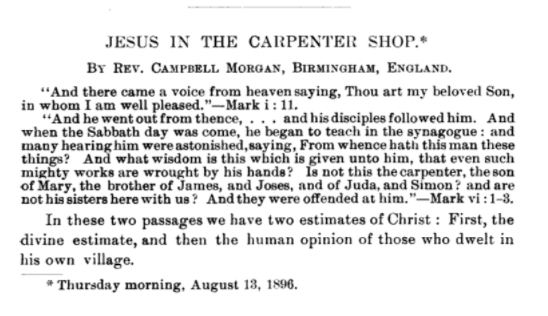
Morgan’s first sermon at Northfield, 1896
Morgan must have made a fairly good impression on Moody, for he was invited back as one of the main speakers the next few years…preaching over a dozen messages each in 1897 and 1898. Moody also invited him to lecture to the students at the Moody Bible Institute. The trip to the USA would prove to be a watershed moment, connecting him with Moody, and giving him a platform that would reach an international audience. It was the first of what would become 54 visits to America to preach and teach.
His reputation as preacher and Bible expositor continued to grow, especially after he published his first book, “Discipleship” in 1897. This, combined with his yearly ministry at Northfield, contributed to Morgan becoming very well known in a short period of time.
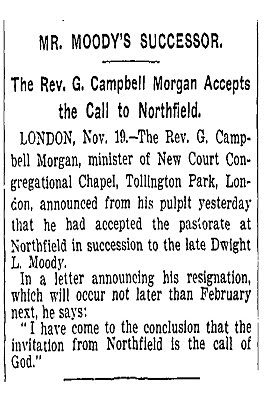
After the death of Moody in 1899 Morgan assumed the position of director of the Northfield Bible Conference and received a Doctor of Divinity degree by the Chicago Theological Seminary in 1902.[3] In 1903 he published what was to become one of his most famous works: “The Crises of the Christ.”
In 1904 he witnessed the Welsh Revival and wrote about it in his book “The Welsh Revival” which he wrote in 1905.
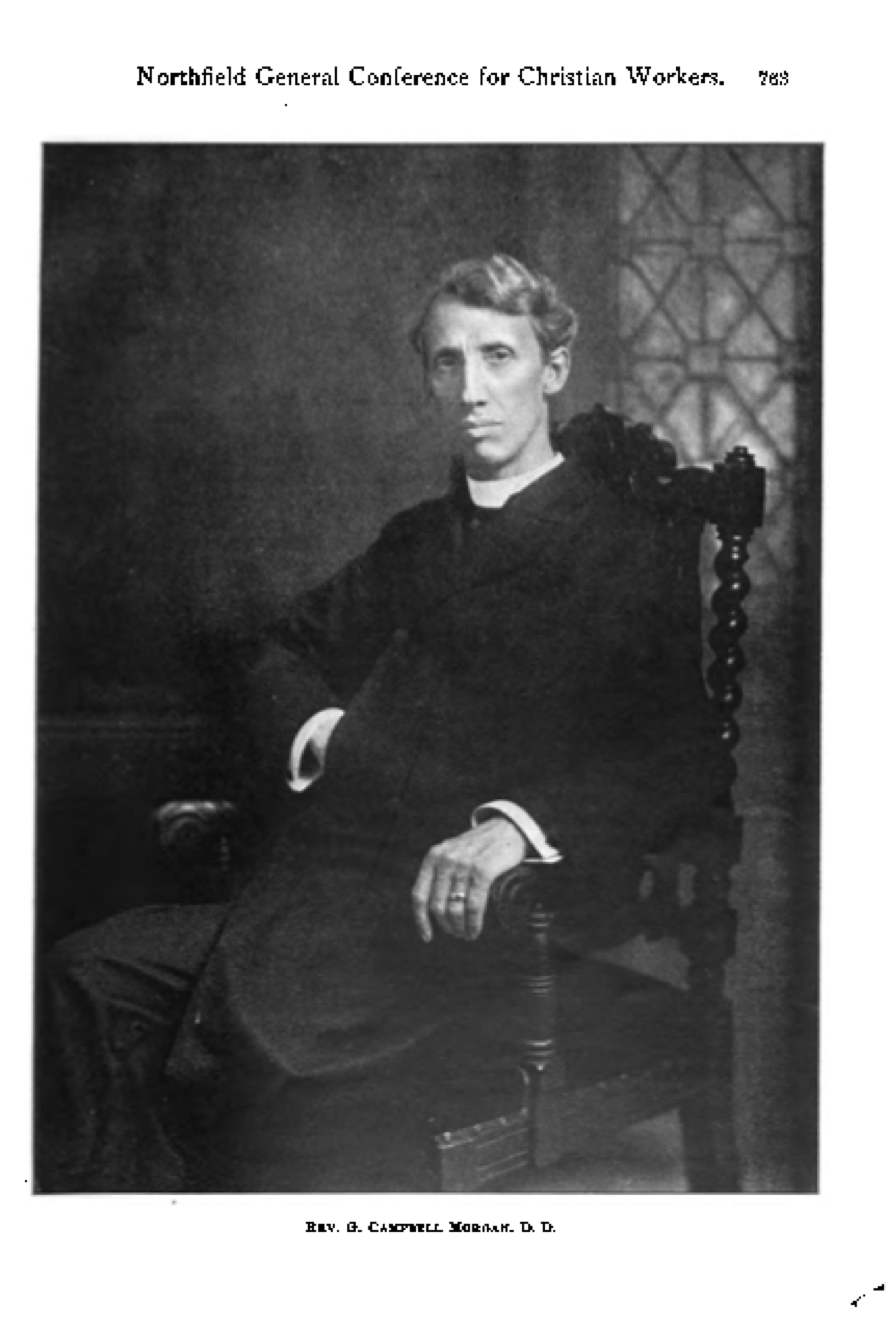
Westminster Chapel: 1904-1919
After five successful years in Chicago he returned to England in 1904 and became pastor of Westminster Chapel in London. When he assumed his role as pastor, the church was practically dead and was called the “white elephant of Congregationalism.” But under his able leadership, Morgan transformed Westminister Chapel into one of the great active churches in England. He worked very hard and very diligently to build Westminster into a strong congregation. In 1916, G. Campbell Morgan left Westminster Chapel to give full time to evangelism and Bible teaching throughout England and America. His famous “Westminster Pulpit Sermons” are from these years of 1904-1916.
In 1904, he determined that England needed a conference similar to Moody’s Northfield Bible Conference. He purchased property at Mundesley, a village by the coast of Norfolk for this purpose. From 1906 to 1914, great 10-day conferences were held each year with speakers such as F. B. Meyer, R. B. Girdlestone, John Hutton, James Orr, W. H. Griffith Thomas, J. H. Jowett, A. T. Pierson, Charles R. Eerdman, and Gipsy Smith preaching to more than 1,000 conference attenders. [4]
During two years of this ministry he was also President of Cheshunt College in Cambridge. Thousands attended his preaching and weekly Friday night Bible classes.
1907-1912 were Morgan’s most prolific writing years, when he penned dozens of books including his Analyzed Bible series and the Living Messages of the books of the Bible. His sermons were also published in the Westminster Pulpit series, beginning in 1906 and continuing for the next 10 years. In 1910 Morgan contributed an essay entitled “The Purposes of the Incarnation to the first volume of The Fundamentals, 90 essays considered to be the foundation of the modern Fundamentalist movement.

Ministry in the USA: 1919-1933
Leaving Westminster Chapel in 1919, he once again returned to the United States, where he conducted an itinerant preaching and teaching ministry for 14 years. During these years he preached in thousands of churches and held meetings in almost every state of the Union. He also held many meetings in Canada and encouraged pastors there to consider expository preaching. Morgan purchased a home in Athens, Georgia which served as a “home base” until 1926 when he again became a pastor. During this time he was also on the faculties of BIOLA in Los Angeles in 1927-28 and Gordon College in Boston in 1930-32.
Return to England: 1933-1945
He returned to England in 1933, where he again became pastor of Westminster Chapel and remained there until his retirement in 1943. He was instrumental in bringing Martyn Lloyd-Jones to Westminster in 1939 to share the pulpit and become his successor. Morgan was a friend of F. B. Meyer, Charles Spurgeon, and many other great preachers of his day.
Morgan and his wife Nancy had four sons (Percy, John, Frank, and Howard) and three daughters (Gwendoline, Kathleen, and Ruth). Howard Morgan succeeded his father as pastor of Tabernacle Presbyterian Church when Morgan returned to Westminster Chapel for his second term in 1932.[5]
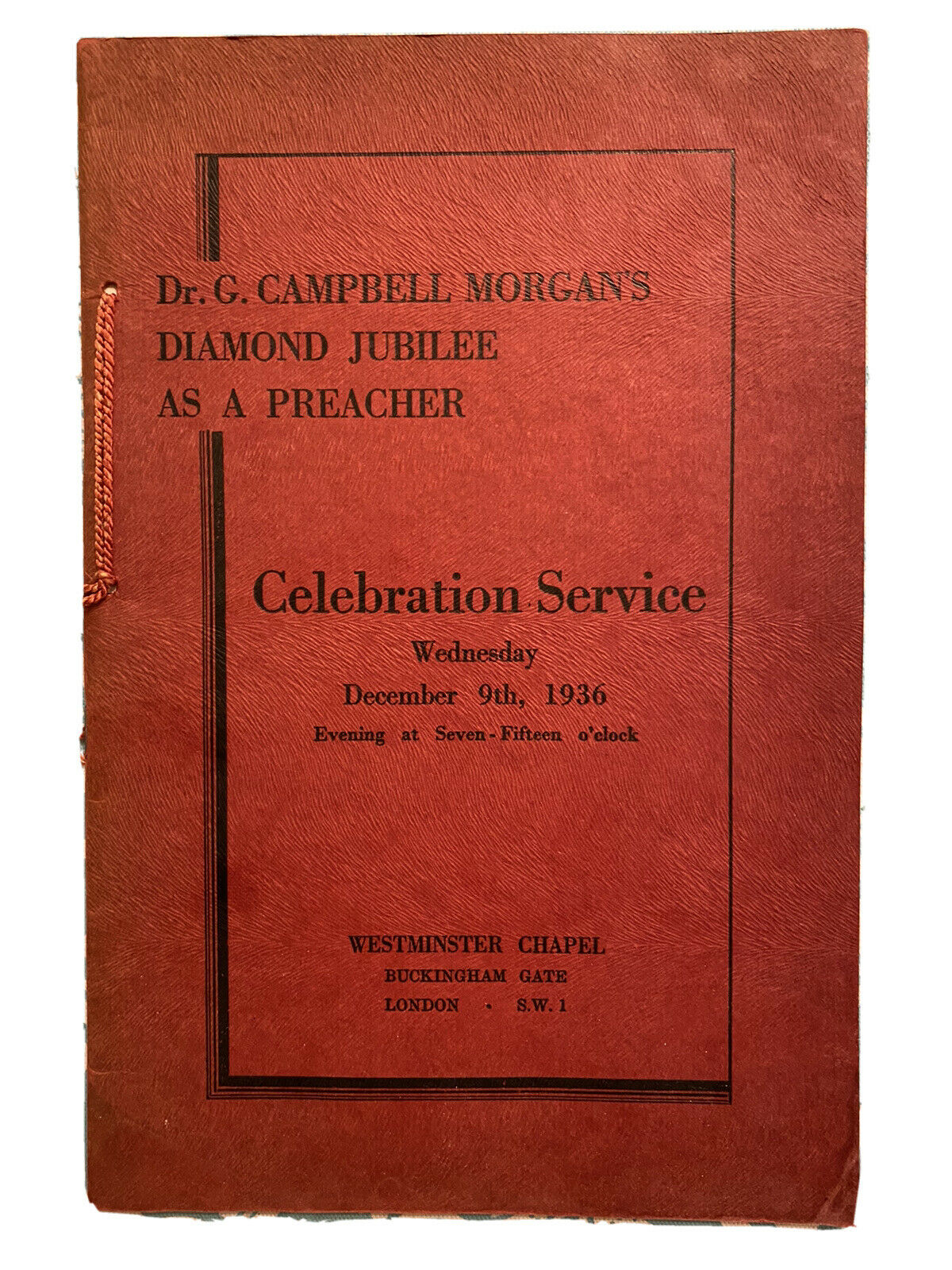
Morgan – 50 years of preaching
In 1943, he became Minister Emeritus at Westminster Chapel. His faithful assistant, D. Martyn Lloyd-Jones, became pastor in his stead. Just a few months before the end of World War 2, on May 16th, 1945 after 67 years of ministry, G. Campbell Morgan died peacefully at his home at the age of 81.
At his memorial service D. Martyn Lloyd-Jones eloquently stated,
When did he come upon the scene? It was immediately after those wonderful campaigns of D. L. Moody and Sankey in this country. There had been those great visitations of the Spirit. Men and women had been converted by the thousand. This great evangelistic movement had come into the whole life of the Church, and what was needed above everything else at that point was someone who could teach these converts. And ‘a man came from God’ whose name was George Campbell Morgan; and he came at the critical moment, at the very right time when all those spiritual emotions and experiences needed to be harnessed and deepened and fostered. The evangelists had done their work; it was time for the teacher; and God sent him.” [6]
Morgan on Time with God:
In 1900 at the Mundesley conference Morgan stated one of the keys to his life and ministry, one that we should all take to heart:
These are evil days. It is the age of rush, of movement, of effort. The old sacred art of contemplation and meditation is almost dead. It is the age when men and women are trying to live even within the Church by dissipating and exciting forms of so called religious services. The old solemn hours of quiet loneliness with God that made the saints of the past are almost unknown. We are carried up and borne forward before we know it on the characteristics of the time. When men and women come to me as they do sometimes and say we need in the Church to catch the spirit of the age and keep level with it, I say in God’s name, No! What we need is to be led by the Spirit of God, and that will send us against the spirit of the age and never along with it.[7]
ENDNOTES:
[1] http://ctslibrary.org/collections/Campbell_Morgan/bio.html
[2] Jill Morgan, A Man of the Word, p.76.
[3] https://albert2u.wordpress.com/2008/11/24/gcampbell-morgan-preacher-sent-from-god/
[4] https://sharperiron.org/article/g-campbell-morgan%E2%80%94-preacher-come-from-god%E2%80%9D-part-1
[5] http://ctslibrary.org/collections/Campbell_Morgan/bio.html
[6] https://albert2u.wordpress.com/2008/11/24/gcampbell-morgan-preacher-sent-from-god/
[7] https://sharperiron.org/article/g-campbell-morgan%E2%80%94-preacher-come-from-god%E2%80%9D-part-2